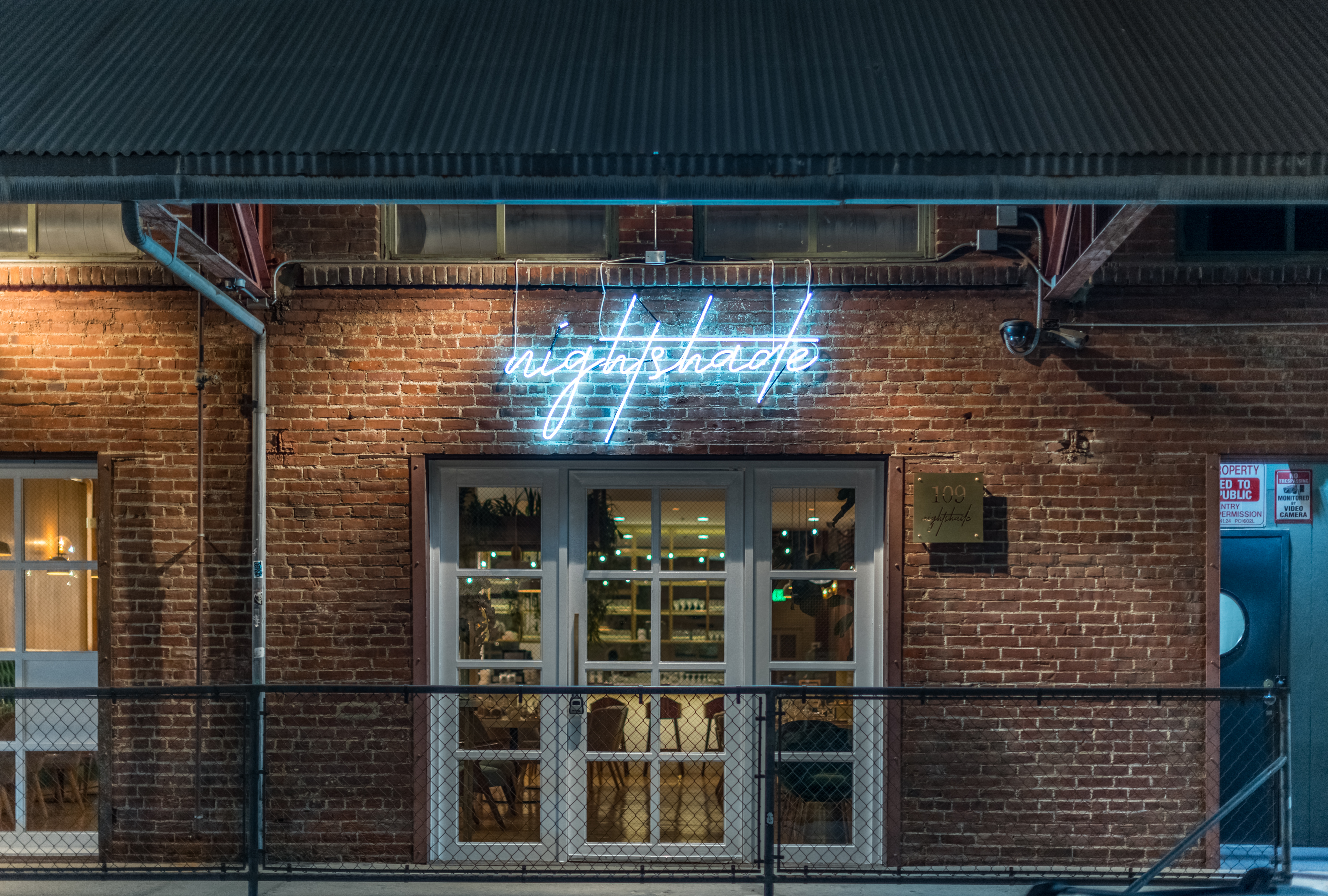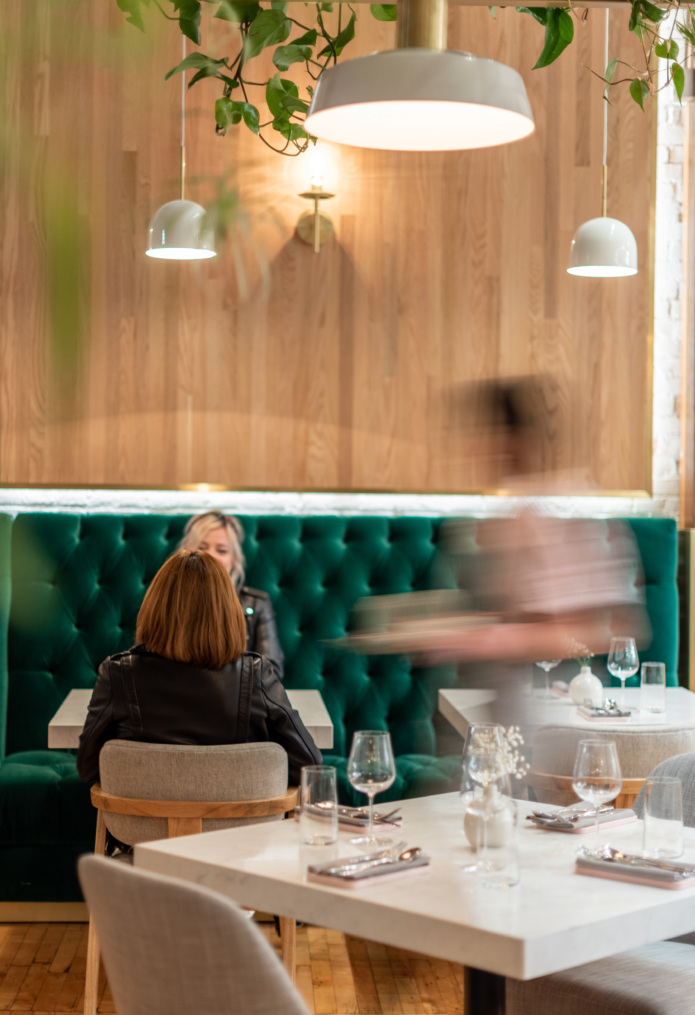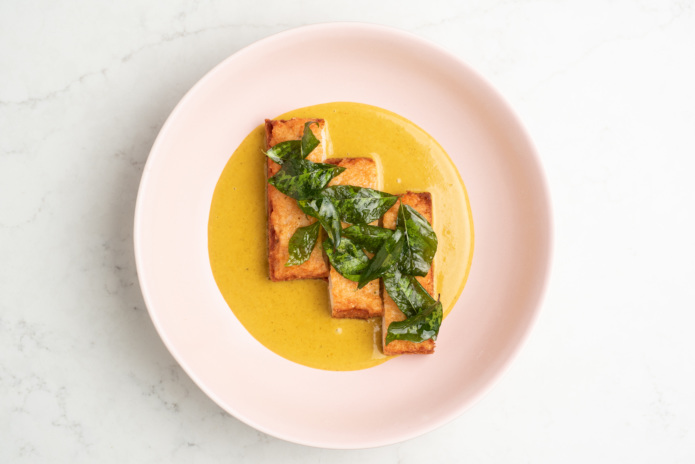
Mei Lin Gets Up Close and Personal at Nightshade

Photo Credit: Wanho Frank Lee.
This is a defining moment for the L.A. food scene. No longer drowning in an ocean of California cuisine, Angelenos can now choose from a hyper-localized pool of personal viewpoints: chefs take inspiration and blend flavors, techniques, and ingredients from a variety of cultures and communities. With mashups like Korean tacos, Sichuan pizza, and Mexican hummus, these Los Angeles chefs are changing the way we eat today.
Enter Mei Lin—the chef and agent of change behind buzzy eatery, Nightshade.
Tucked down an alley in the Arts District, Nightshade beckons visitors with its industrial exterior and artistic neon sign. Inside, the restaurant is lined with lush teal velvet banquettes and blond wood, and cascading greenery hangs from the ceiling. There are stools along the bar, and a chef’s counter, where Lin and her team cook in full view. The room is stylish and comfortable, sleek but not fussy. It’s a restaurant that can live only right now and only in L.A.
“I’m drawing from all the different cultures in one restaurant. It’s what I love eating and cooking: Korean influences, Chinese flavors, and very travel-inspired as well,” Lin says. “But ultimately, my biggest focus is to just have our guests feel at home, like they are in my home.”

At Nightshade, Lin recreates home from start-to-finish. Take one of her signature dishes, the shrimp toast, for example. “I grew up in an American-Chinese restaurant in Dearborn, Michigan, and shrimp toast is just one of those things I’ve always loved,” the chef says. It might not be an iconic Los Angeles dish—yet—but Mei Lin’s version has achieved superstar status. No basic variation, hers includes bread slices topped with a robust shrimp mousse (made with schmaltz, no less), served in a pool of vibrant yellow curry, and topped with fried green curry leaves.
In what can only be described as a sensational sensory experience, the aroma hits when the dish reaches the table, and colors pop from a pretty pink bowl. This blend of the familiar and the new—an elevated take on something you’d find in any Americanized Chinese restaurant—is, in essence, pure Lin.

The result is a seemingly simple yet incredibly complex dish with bold flavors and light textures. It works so well that Food & Wine named Lin’s shrimp toast “Dish of the Year” (and Nightshade “Restaurant of the Year”).
After helping at her family’s restaurants near Detroit, Lin spent her formative years working in kitchens with some of the biggest names in the industry: Michael Symon, Marcus Samuelsson, Wolfgang Puck, and Michael Voltaggio. When she moved to L.A., she found herself exploring farmers markets in different communities and falling in love with neighborhoods like Koreatown. Nightshade is the culmination of Lin’s experiences, from the Midwest to Mid-Wilshire and everywhere in between.
But Lin isn’t just trying to replicate: She takes the familiar and adds her own whimsical twists, creating utterly memorable and delicious dishes. Take the Mapo tofu, a fiery stew of bean curd and pork and a staple in Sichuan cuisine, which is transformed into a meat sauce for lasagna. Inspired by her favorite Korean cold noodle soup, dongchimi-guksu, she laces kanpachi crudo with kimchi and radish water. And there’s no question that teenage years spent at Outback Steakhouse inspired her famed blooming onion. It’s a gorgeous interpretation—a delicately fried flower in full bloom, with pull-apart golden petals, a coconut sauce for dipping,and spiced with tom yum seasoning—an homage to the spice packs found in instant soups.

The Nightshade menu is already full of dishes that might cause a revolt if they disappear. And Lin continues to add to it, with dishes like schnitzel, an ode to her time working with executive chef Eric Klein at Spago in Las Vegas. Her version is a bone-in fried pork chop flavored with five-spice powder and Szechuan peppercorns, and it comes with a cooling cucumber and tomato salad.
“Schnitzel was always on the menu when I worked at Spago, but the spice we make here is inspired by Taiwanese fried chicken you’ll find at boba tea houses. I made [it] for my family one day, and it was just a winner.” says Lin. “I really learned how to cook from Eric [Klein]. He taught me the fundamentals of seasoning and balance.”
To finish, dessert promises another layer of artful execution. Lin’s chef de cuisine, Max Boonthanakit, pulls from various touch points for his masterful creations. Dishes are listed minimally on the menu, but are served as structural works of art: almond sorbet with tangerine granita is hidden beneath discs of white chocolate— a riff on almond Jell-o traditionally served at Chinese restaurants. With the addition of citrus, however, it tastes like a divine creamsicle. A vibrant green orb of coconut mousse served in a bowl that looks like a coconut is reminiscent of pina colada, one of Boonthanakit’s favorite virgin cocktails.
The trick is to compose with nuance, no matter where the chefs find inspiration or the number of ingredients used. “Overall, a dish has to fit in with the concept,” Lin says, underscoring that, as in many things, precision and vision are paramount: “It can’t just be a mishmash. And it requires a lot of testing before [a final menu] reaches the table—maybe too much.” One thing’s for certain, it doesn’t go unnoticed.















